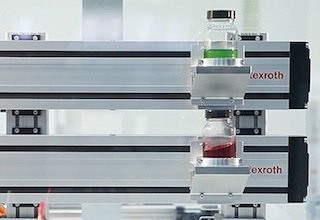Adaptive Systems motion control technology from Bosch Rexroth helps minimize unwanted movements directly at the drive level in industrial machinery, helping increase process throughput by up to 50 percent. It alleviates movements including oscillations, vibrations, sloshing and sway.
Aimed at applications ranging from packaging and printing to material handling, machining and semiconductor manufacturing, the technology is said to offer productivity gains from increased throughput and extended machine life.
Vibrations and oscillations are simple, repetitive motions, but they’re governed by complex factors of wave physics. The complex nature of waves often makes traditional vibration control methods ineffective. Because implementing vibration damping and avoidance techniques requires a control system that can quickly adapt to varying process, material and application changes, Rexroth offers Adaptive System technology directly at the drive level, rather than at the higher control level.
Less vibration not only reduces dimensional variation and damage to the product, but also permits shorter stabilization and transient times to increase machine throughput. In addition, reducing vibration reduces mechanical stress, which extends machine life.
Rexroth Adaptive System motion control can handle high-speed inputs and deterministic events with closed-loop response times. For example, current closure can be accomplished in 62.5 microseconds, speed loop closure in 125 microseconds, and position closure in 250 microseconds. The Adaptive Systems technology is implemented from the company’s IndraMotion MLD drive-based motion logic controller.

One area where the technology is especially effective is in controlling slosh. With packaging applications that involve liquids, acceleration or deceleration of the package induces motion—or slosh—in the liquid. This negatively affects the folding, filling, sealing and measuring processes.
Because package movement is controlled by servo drives, using adaptive technology to minimize slosh provides several benefits. It reduces the requirement for empty reserve space in the container, which can help reduce the amount and expense of packaging material. Greater stability in the fluid meniscus also allows the use of optical level sensors to provide feedback to further optimize motion control. It also shortens stabilization times and cuts down on the transient time for contents to settle. This means faster filling, sealing and machine cycle times.
Adaptive System technology for controlling slosh is particularly beneficial in packaging lines for beverages, chemicals, oils and pharmaceuticals. Packaging lines that implement anti-slosh motion control can typically experience throughput improvements of 10 to 50 percent.


Leave a Reply
You must be logged in to post a comment.